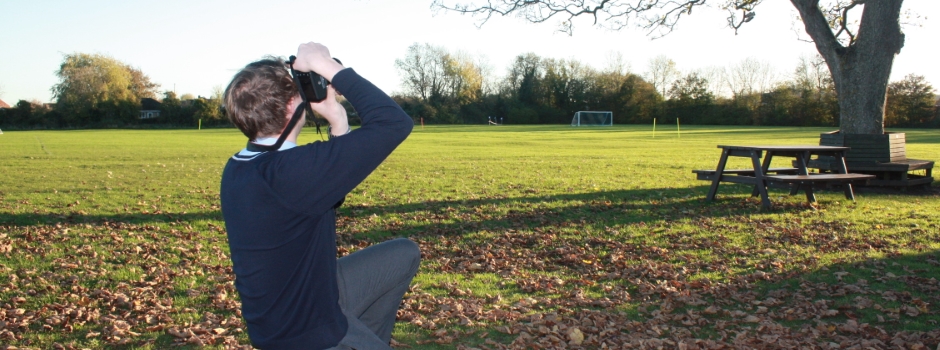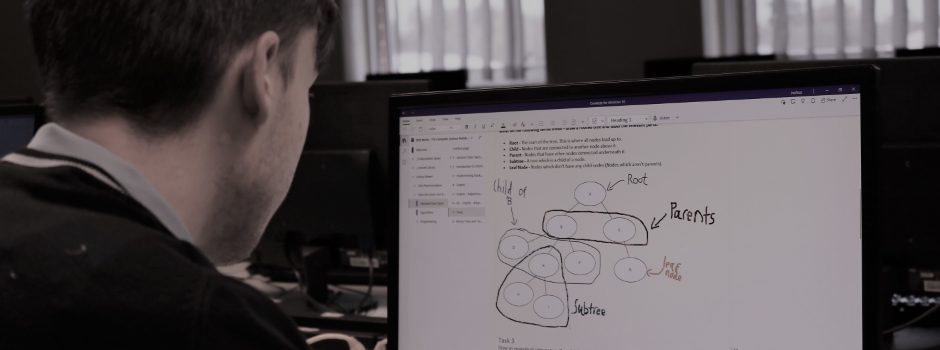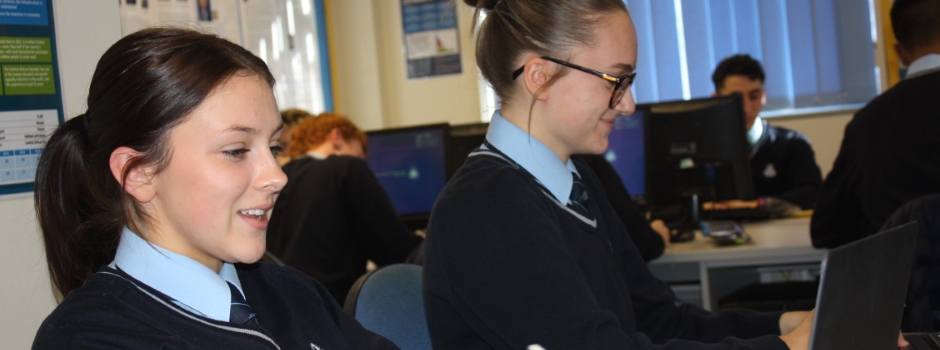



















































"The support from staff and students allows you to exceed your expectations."
Computer Science Dept - Curriculum on a Page
Showing the curriculum by subject
Computer Science
Curriculum Details - 2023/2024 (Current)
| Year | Term 1 | Term 2 | Term 3 | Term 4 | Term 5 | Term 6 |
| 9 | Data Representation 1 - Analogue and digital signals, binary addition and hexadecimal, storing characters and images. | Programming 1 - Turtle, repetition, sub programmes. | Programming 1 - Data types and user input, parameter passing. Cyber Security - social engineering, security issues, backup and recovery. | Network Security - Authentication, encryption, access control. | Computer Systems - Hardware - Von Neumann architecture, Fetch Decode Execute cycle, main memory and secondary storage. | Computational Thinking - Searching and sorting algorithms. |
| 10 | Programming 2 - flow charts and programmes using selection. | Programming 2 - manipulating strings and random number generation. Trace tables - evaluating the values of a programme by stepping through it line by line. | Data representation 2 - Logical and arithmetic binary shifts, storing sound, data compression. | Programming 3 - Lists and loops. | Networks - Types of networks, TCP/IP model, topologies, hardware, speed and bandwidth. | Programming 4 - Formatting strings, file reading and writing. |
| 11 | Programming - Review of all areas Software and classification of programming languages. System, application and utility software. | Environmental, ethical and legal issues relating to computing. | Revision - Y9 topics. | Revision - Y10 topics. | Revision - Targeted topic revision. | Programming Projects - working on developing the programming skills to produce tasks ready for larger programming writing at A Level. |
| 12 | Data Representation - Sets and Bases, Floating Point Binary, Compression and Encryption. Data structures - Creating ways of storing data that represent behaviours - Stacks, graphs. Programming. | Data structures - trees. Algorithms - Reverse Polish Notation, Dijkstra's algorithm. Programming. Programming - covering simple concepts to ensure good use from GCSE work. Sequence, Selection and Iteration. Using inbuilt as well as creating functions. | Data structures - Queues, dictionaries, hash tables, vectors. Algorithms - Searching, sorting, efficiency. Databases design and normalisation. Programming. Programming Tasks - tasks that help review some of the theory topics already covered to build on programming skills. | Databases - SQL queries. Table creation, insertion/updating of data, retrieval of data. Programming paradigms and a focus on Object Oriented Programming. | Databases - RDBMS and Concurrent access. CRUD, REST, JSON and XML. Theory of computation - Regular Expressions, Finite State Machines, Mealy Machines, Turing Machines and Big O notation. | Big Data and Functional Programming. Programming Project |
| 13 | Communications and Networks Fundamentals of Computer Systems. | Programming Project Fundamentals of Computer Systems. | Programming Project Consequences of uses of Computing Computer Organisation and Architecture. | Revision. | Revision. | N/A |
Computing
Curriculum Details - 2023/2024 (Current)
| Year | Term 1 | Term 2 | Term 3 | Term 4 | Term 5 | Term 6 |
| 7 | Network Introduction and eSafety/Cyber Security - this covers how to use our main digital systems as well as introducing some potential eSafety issues and how to avoid them becoming a problem. | Initial Assessment of problem solving skills using the Bebras Algorithms - Looking at what an algorithm is and some common uses for algorithms - concentrating on searching and sorting. | Programming 1 - an introduction to Python using turtle. Spreadsheets - using Microsoft Excel to calculate results as well as displaying data as graphs. | Word Processing and Typing Skills - we look at the advanced features of Microsoft Word to produce professional looking documents quickly. This unit also looks at developing keyboard skills. Data Representation 1 - binary, denary and hexadecimal number systems. | Microbits - programming using programming blocks and using the inbuilt sensors and Bluetooth connection wihtin the Microbits to send messages. Presentation Skills - Developing PowerPoint skills to develop an interactive presentation as well as actual presenting skills. | Computer Communications - looking at how data is moved between computers and also what is meant by the Internet. Encryption and Compression - looking at how data is kept secure by encryption and also how we can move data around networks more quickly by using compression. |
| 8 | Cyber Security - A look at how computer systems have vulnerabilities and how to protect against these and also competing in a national competition. Computer Science Careers - A look at possible careers in computer science and related fields. | Problem Solving and Bebras Competition - looking at different problem solving techniques and how they can help when programming as well as in everyday situations. | Programming 2 - data processing and selection using variables in Python. | AI - A look at what is meant by aritificial intelligence and machine learning. We look at how these model are built as well as how they can become biased. Data Representation 2 - How data is stored in a computer system with a focus on how images and text are represented as binary. | Hardware and Software - A look at the main components of a computer system with a specific look at the CPU and logic gates. The software section looks at the operating system and utility software. Web Development - Using HTML, CSS and JavaScript to make a small website | Web Development - conitnued from term 5. eSafety - A look at possible dangers and health concerns relating to the use of technolgy and how these can be avoided. |